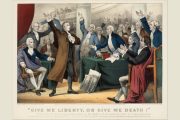
As Americans celebrate the Fourth of July and the signing of “the” Declaration of Independence, it is valuable to recall that there were several such declarations (and similar legal documents) signed throughout the original 13 colonies published before and immediately after the official Declaration we commemorate this holiday.
There were, by best count, more than 90 of these documents declaring formal legal separation from the crown of Great Britain. As research in this area continues, more of them will be found, however.
Perhaps one of the most enlightening aspects common to all these “declarations” (that word is in quotes because few of them were actually so titled) is the authority by which the severance with England was made. Almost every one of these statements reiterated the independence of the political entity drafting them, not of the “nation” of the United States.
Moreover, nearly every one of these important documents followed a pattern of drafting that was well established in the history of English law and government. A declaration was formal and was issued for very specific purposes, unlike its less legalistic cousin the address or petition.
As preeminent Founding-era historian Pauline Maier teaches, “A declaration was a particularly emphatic pronouncement or proclamation that was often explanatory: from the fourteenth century “declaration” implied “making clear” or “telling.”
Furthermore, declarations were also aimed not only to inform some authority of the issuer’s intent, but to “command broad public support,” as evidenced by the many such documents issued by the king and parliament during the English Civil War.
Beyond their more public purpose, declarations had an accepted and expected legal element, as well. Declarations, as legal instruments, were required by practice and procedure to contain “a written statement of claims served on the defendant at the commencement of a civil action.” The list of grievances, furthermore, should be written in “plain and certain” language.
In many instances throughout the history of the American colonies, declarations combined several of these purposes. For example, the Declaration of the Causes and Necessity of Taking Up Arms issued by the Second Continental Congress on July 6, 1775 summarized the deprivations suffered by the colonies at the hand of the crown and parliament in order to evince the “justice of our cause” to “the rest of the world.” This list of injuries was meant not only to put parliament on notice of legal allegations of wrongdoing, but to inspire support from the American populace.
Similarly, the 90 or so town, county, and colony declarations made around the time of “the” Declaration of Independence laid out lists of violations of the rights of Englishmen committed by king and parliament, all of which, the authors of the resolutions believed, justified the breaking of the bonds that held them tied to England.
After being published in newspapers and tacked up in public places, these local statements conformed in every particular with the definition of declaration as accepted for centuries in England.
Of all the historic declarations in English history, the one with which Americans were most familiar was the Declaration of Rights of 1689. This declaration ended the reign of James II and brought William and Mary to the English throne. As to the impact the Declaration of Rights had in the American colonies, Maier writes, “It became for the colonists a sacred text, a document which, although not celebrated with religious imagery, provided a statement of established, fundamental political and legal truths.”
It isn’t, however, as if with the publication of this declaration, the colonists developed a devotion to liberty. In fact, the reaffirmation of the rights in the Declaration of Rights of 1689 was but one such step in a long road of preceding proclamations of fundamental rights. At least seven times between 1327 and 1689, Englishmen forcibly removed a monarch from the throne. These depositions were not taken lightly, however. Declarations justifying this extreme always accompanied the dethronement.
As Maier explains, “Those justifications served over time to limit the legitimate deposition of a monarch to cases in which he was blatantly incompetent (rex inutilis) or bad in the sense of having violated established laws, customs, and moral standards, whether on his own or by stubbornly following (as was said of Edward IV in 1484) ‘the counsel of persons insolent, vicious, and of inordinate avarice, despising the counsel of good, virtuous, and prudent persons.’”
With this understanding and example in mind, Thomas Jefferson set about drafting the preamble of the Virginia constitution. In the spirit of the Declaration of Rights of 1689, Jefferson wrote:
Whereas George Guelf king of Great Britain and Ireland and Elector of Hanover, heretofore entrusted with the exercise of the kingly office in this government hath endeavored to pervert the same into a detestable and insupportable tyranny.
The authority asserted by Jefferson was not America or the colonies, but Virginia. In fact, Jefferson was not declaring that George III was no longer the king of Great Britain (as the Declaration of Rights had done to James II), but he was declaring that his right to rule was now revoked inside the Old Dominion.
Next, in complete compliance with the historic procedural demands of a declaration, Jefferson listed 16 “acts of misrule” that justified Virginia in calling for the immediate deposition of George III.
Finally, lest there be anyone in the colony confused by the effect of this declaration, Jefferson wrote:
Be it … enacted by the authority of the people that the said George Guelf be, and hereby is deposed from the kingly office within this government and absolutely divested of all its rights, powers, and prerogatives; and that he and his descendants and all persons acting by or through him, and all other persons whatsoever shall be and for ever remain incapable of the same; and that the said office shall henceforth cease and never more either in name or substance be re-established within this colony.
Throughout the spring and early summer of 1776 other towns and colonies, weary of waiting on the Continental Congress to do what most agreed needed to be done, declared by one means or another their independence from Great Britain. Although they varied somewhat in form, their function was the same: justify the severing of political bands with England by listing the grievances suffered at the hands of parliament and the crown.
What is the purpose of this rehearsal of American declarations of independence? To remind Americans that just as our ancestors did not wait on the Continental Congress to declare the arbitrary injustices of George III and parliament as null and void within their individual borders, we need not wait on Congress to repeal this or that unconstitutional federal act.
States, as the creators of the federal government and as sovereign political entities, possess sufficient authority to declare independence from the “several acts of misrule” perpetrated daily by Congress and by a man who has usurped monarchical prerogatives in open and hostile violation of the God-given rights of Americans and the Constitution that protects them.
Joe A. Wolverton, II, J.D. is a correspondent for The New American and travels nationwide speaking on nullification, the Second Amendment, the surveillance state, and other constitutional issues. Follow him on Twitter @TNAJoeWolverton and he can be reached at [email protected].




